Bayou Community Struggles with Sinkhole
Air Date: Week of July 5, 2013
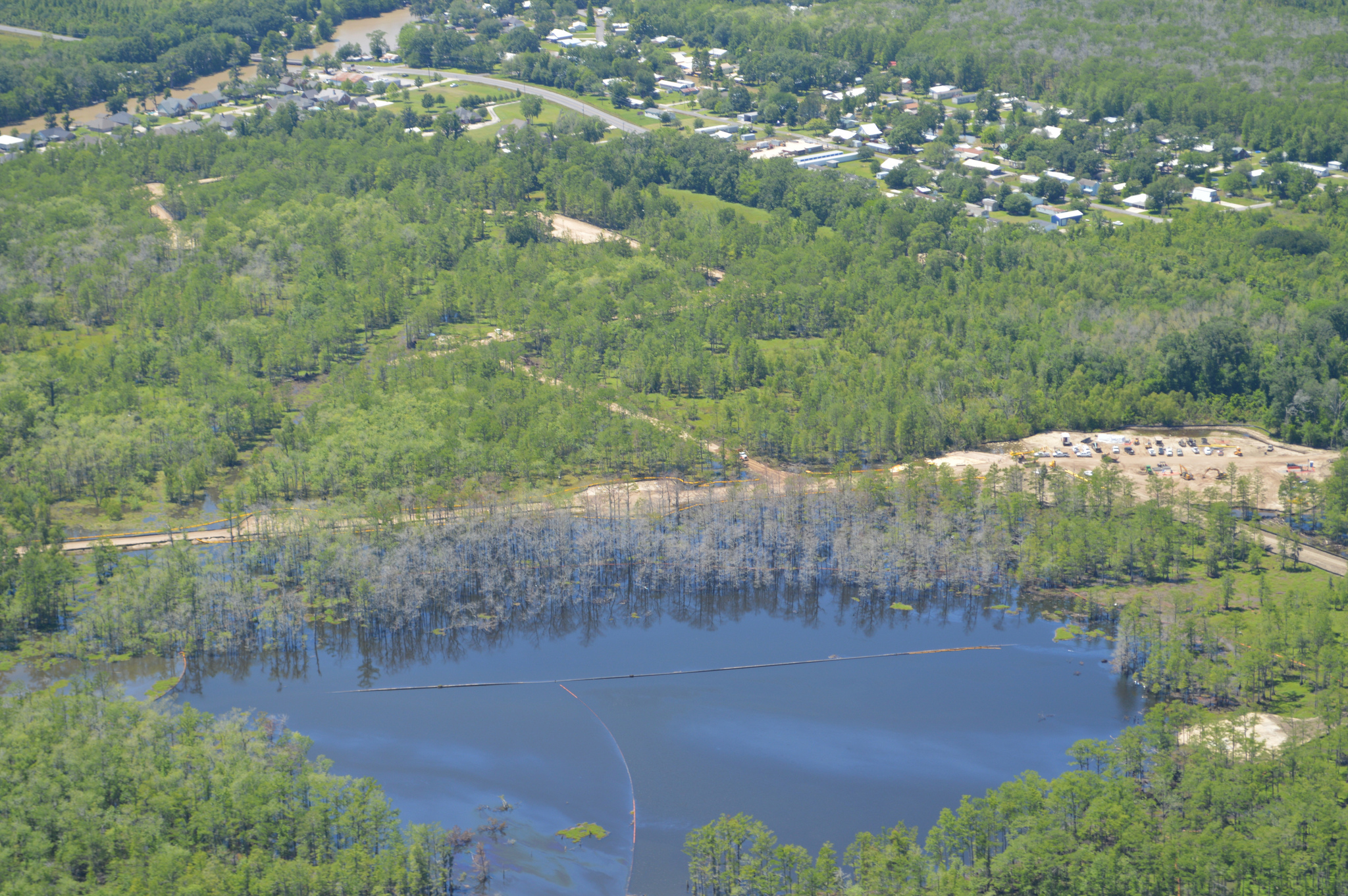
The sinkhole from the air. It is now approximately 20 acres in size. (photo: Louisiana Environmental Action Network).
From hurricanes to oil spills, the people in Southern Louisiana are used to environmental threats. But as Emmett FitzGerald reports, a huge sinkhole in the tiny swamp community of Bayou Corne is giving residents unique and unpleasant challenges.
Transcript
CURWOOD: It’s Living on Earth. I’m Steve Curwood. The people in the bayou country of southern Louisiana are used to environmental anxiety - what with frequent hurricanes, oil spills, and chemical explosions at plants along what’s known as the petrochemical corridor. But for the past year, residents of the tiny town of Bayou Corne have been struggling to cope with an unexpected new problem that opened up right in their own backyard. In August 2012, a sinkhole appeared just outside of Bayou Corne and it's grown to nearly 20 acres in size. It’s brought tremors, dangerous gasses, and a host of uncertainties to the people living there. Living on Earth’s Emmett FitzGerald has our story.
FITZGERALD: Residents of Bayou Corne, a small community on the edge of a cypress swamp in southern Louisiana, call the place a “bayou paradise.” Dredged canals snake between the streets. Each house has a driveway out front and a dock out back with boat access to the bayou.

Nearly every home in Bayou Corne has access to canals that lead to the swamp (photo: Emmett FitzGerald)
SUBRA: I mean, if you were from New York City and you came down here you thought you were in heaven here, right?
FITZGERALD: Wilma Subra is an environmental scientist.
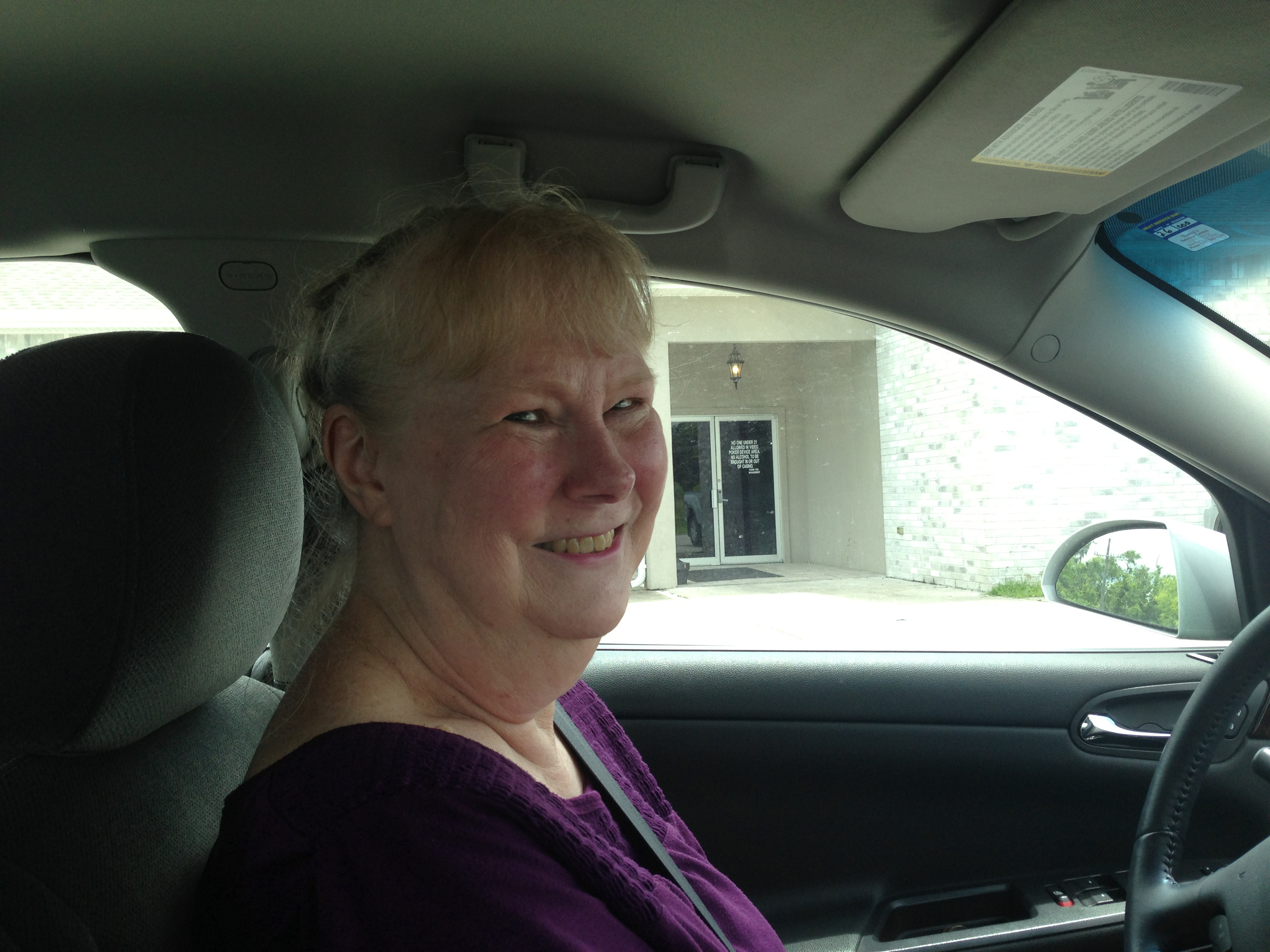
Wilma Subra, environmental scientist with the Louisiana Environmental Action Network (photo: Emmett FitzGerald)
SUBRA: They even have a little Mardi Gras parade.
FITZGERALD:Right down this street?
SUBRA: Uh huh. Isn’t it beautiful?
FITZGERALD: Wilma’s been monitoring the sinkhole since it appeared. As we drive into Bayou Corne, the tranquil town looks more like a construction zone. Dump trucks and backhoes trundle past, kicking up clouds of dust. Wilma says they’re building a sand berm around the site.
[DRIVING ON THE ROAD]
FITZGERALD: Through the trees we catch a glimpse of the sinkhole.
SUBRA: Look down there.
FITZGERALD: Oh yeah, oh my God.
SUBRA: You saw it?
FITZGERALD: Yeah, it looks just like a lake.
SUBRA: Yeah, with crude oil floating on top on it.
FITZGERALD: We turn down a quiet street lined with small, brick homes, and Wilma spots a familiar man in a sweaty shirt pushing a mower across his yard.
SUBRA: Hi, Dennis. He can’t hear me. Hi.
[LAWN MOWER TURNS OFF]
LANDRY: How ya’ll doing?
FITZGERALD: Good. How are you doing?
LANDRY: Too hot. Well, we got an interesting little story going on here.
FITZGERALD: Dennis Landry was born on the bayou. He owns a lodge called Sportsman’s Landing with three “Cajun Cabins” for fishermen and honeymooners. Since the sinkhole, Sportsman’s Landing has served as the command center for various government agencies. As dump trucks rumble by, Dennis says he saw the early warning signs of the disaster to come in June 2012.

The view from Sportsman’s Landing, Dennis Landry’s business (photo: Emmett FitzGerald)
LANDRY: My wife and I were out for a leisurely pontoon boat ride down Bayou Corne.
FITZGERALD: The Landrys noticed strange bubbles rising up in the swamp.
LANDRY: When I first saw the bubbling I looked at it and said, this doesn’t look right.
FITZGERALD: Dennis thought it must be a leak in a nearby natural gas pipeline. But when he called the gas company, they weren’t so sure.
LANDRY: They called me back and said, ‘thanks for calling it in, but we really don’t think it’s our pipeline’. And I couldn’t believe it. I said ‘golly, it’s only twenty feet from your line.’
FITZGERALD: The gas company was right. Scuba divers checked it out, and the bubbles were coming directly from the ground. For the next few weeks, officials tried to sort out what was going on.
LANDRY: Then of course the world changed, on August 3rd. August 3rd, the sinkhole occurred at the Texas Brine facility, and everyone pretty much knew immediately, an old abandoned cavern that they had shut in a couple of years prior, apparently had failed.
FITZGERALD: Now, it takes a little geology lesson to understand all this. Under Louisiana’s swampy earth lie massive fingers of salt. Companies drill into these “salt domes” for a variety of reasons. Some mine salt to melt ice on roads up north during the winter. Others store natural gas in the salt caverns. And some companies drill into the domes to make brine.
Sonny Cranch is the director of media relations for Texas Brine, a company that has been drilling into the salt dome beneath Bayou Corne for over 30 years.
CRANCH: The process is to drill a well down to about 6,000 feet and start injecting water.
FITZGERALD: The water dissolves the salt creating a hyper-saturated solution. Next, the company pumps the brine to petrochemical plants along the Mississippi river, where they use the chloride to make plastics.
CRANCH: We’ve heard of polyvinal chloride, PVC pipe, well guess what, this is where that comes from.
FITZGERALD: This particular cavern was drilled in 1982. After nearly 30 years of extracting brine, the company began to notice structural problems in 2010. In June 2011, with approval from the Office of Conservation, they plugged the well and closed the cavern.
CRANCH: And a year and two months later we have a sinkhole appear. It’s right up there.
FITZGERALD: What exactly happened is still a little unclear, but at some point after Texas Brine abandoned their operation, the side of the salt cavern collapsed, causing the sinkhole to open up at the surface. As debris continues to slough off the sides, the sinkhole keeps growing. Right now,
BOUDREAUX: it’s about a thousand foot in diameter.
FITZGERALD: And how deep?
BOUDREAUX: Last sonar put it at about 174 feet at its deepest point.
FITZGERALD: John Boudreaux is the Director of Emergency Preparedness for Assumption Parish, where Bayou Corne is located. Parish officials are currently running tests to determine how big the sinkhole will get. Many residents have reported feeling tremors, but at this point, Boudreaux says the biggest threat has to do with that mysterious bubbling in the bayou. When the sinkhole opened up, it released natural gas from deep underground into the aquifer beneath Bayou Corne.
BOUDREAUX: The risk to the community, number one, the shallow gas, of it coming to surface especially underneath a home and possibly getting up to an explosive level.
FITZGERALD: So, to avoid explosions and reduce the gas in the aquifer, Texas Brine is flaring it off around the clock. Flames leap from pipes sunk into the ground. Although Boudreaux put the town on an evacuation order back in August, about a third of the residents have stayed. Texas Brine installed air-monitoring equipment in many of their homes, including Dennis Landry’s.
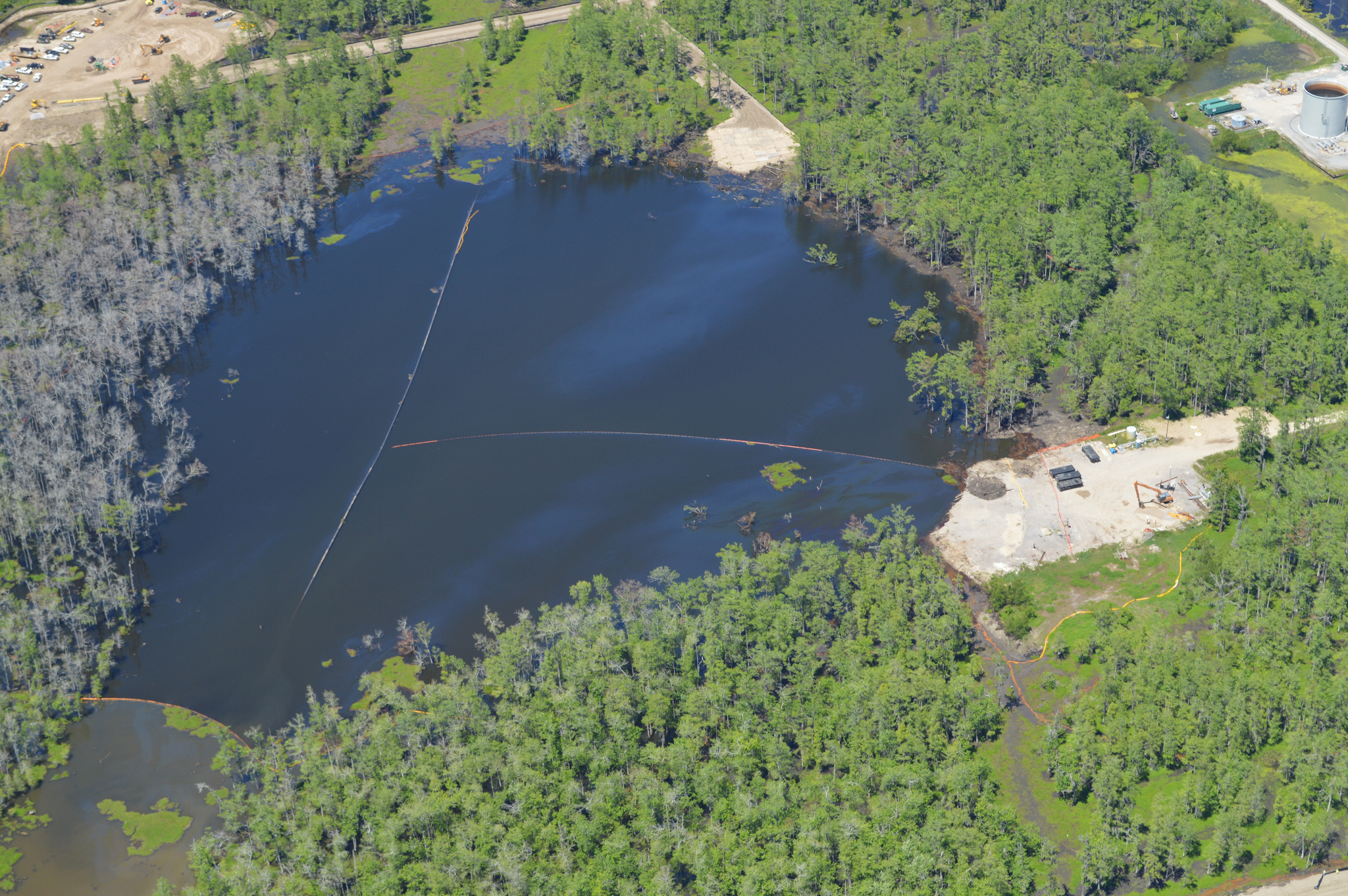
The sinkhole from the air. It is now approximately 20 acres in size. (photo: Louisiana Environmental Action Network).
LANDRY: So we’re living with gas monitors in our homes to alert us. In the unlikely event that gas would get under our slabs and somehow work its way into the house.
FITZGERALD: Dennis is determined to stay in Bayou Corne, but not everyone is as willing to risk it. As Wilma and I turn onto a street called Sauce Picante, we spot two kids playing in the backyard of a small white house. I knock on the door to see who’s home.
[KNOCKING, COUNTRY MUSIC PLAYING]
FITZGERALD: Jennifer Gregoire has been living in Bayou Corne for the past six years.
[HOUSE DOOR OPENS]
GREGOIRE: Hi.
[FITZGERALD: Hello.
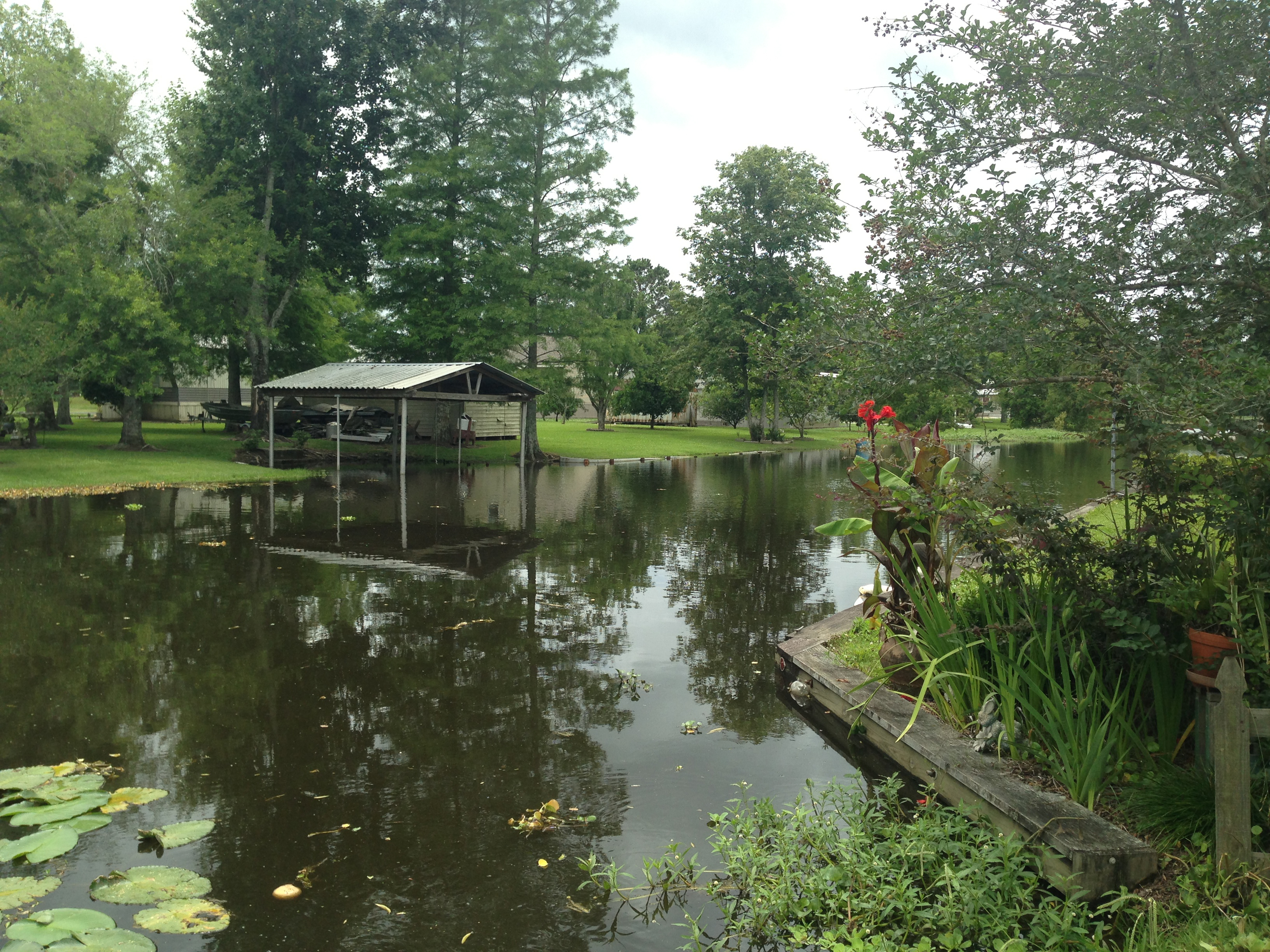
Most families in Bayou Corne own their own boat (photo: Emmett FitzGerald)
FITZGERALD: She and her husband were raising their family here, but she says the sinkhole changed all of that.
GREGOIRE: Come home to check on the house and see that everything was ok and I noticed there were bubbles in the yard. So we call John Boudreaux and he come out, and you could feel the pressure of the bubbles coming out of the ground. It’s nerve-racking.
FITZGERALD: Jennifer and her husband decided that they couldn’t put their children in danger, so they moved out. For the first few months they bounced between hotels, coming home every few days to check on the house. Jennifer says it was tough on the kids.
GREGOIRE: People yelling in the hotels. You don’t know who they are, who’s living next to you. It’s not fun. It’s not a good situation.
FITZGERALD: Eventually the Gregoires bought a camper in the nearby town of Pierre Part. Since the sinkhole, Texas Brine has been paying every household $875 a week for housing and other costs. Jennifer says it’s not enough.
GREGOIRE: It took everything we had to get a camper. No help from Texas Brine, what does $875 do a week? How far can you stretch that between a mortgage, husband working out of state. We had to wait until after December to buy a camper.
FITZGERALD: Sonny Cranch is quick to point out that Texas Brine didn’t want any of this to happen.
CRANCH: Texas Brine didn’t sit down and say, let’s just see if we can cause a breach and ruin everybody’s lives, including ours. It happened, and we’ve been trying to deal with the aftermath ever since.
FITZGERALD: But when homeowners began calling on Texas Brine to buy them out, the company was slow to respond. On May 20, 2013, Louisiana governor Bobby Jindal came to town with strong words.
JINDAL: More than 350 lives have been impacted by this sinkhole. For months we’ve been pressuring Texas Brine to step up to the plate and do the right thing. They are responsible for this sinkhole. They need to clean up the mess they have made; they need to do right by our people.
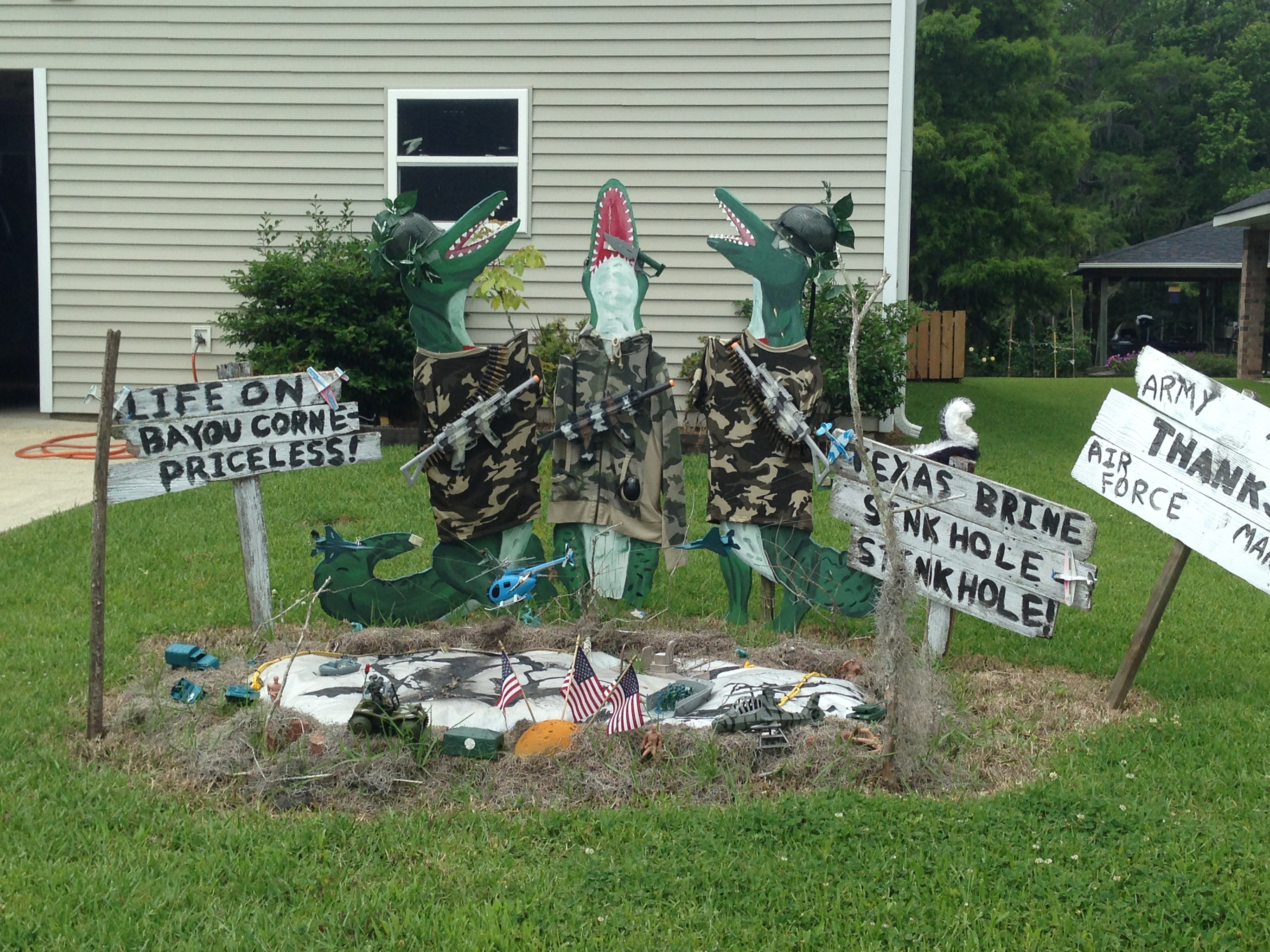
Bayou Corne residents send a message to Texas Brine with these piece of public art (photo: Emmett FitzGerald)
FITZGERALD: Jindal’s speech might have had an effect. On May 25th, Texas Brine announced buyout offers based on the value of the property in the spring of 2012, plus some cash for additional expenses. As of the end of June, 44 homeowners had agreed to terms with the company. But the Gregoires aren’t interested in dealing with Texas Brine.
GREGOIRE: To be frank I don’t want to speak with Texas Brine about the buyout.
FITZGERALD: Jennifer says she doesn’t trust the company, and that one of her neighbors got an offer that was far too low.
GREGOIRE: $75,000 dollars less than what their house was appraised for. No thank you.
FITZGERALD: Along with many other residents, the Gregoires are now filing suit against the company. This is the first known example of a sinkhole caused by the collapse of a salt brining cavern, but Wilma Subra says the whole situation is painfully familiar. In 2003, a natural gas storage cavern leaked into the aquifer beneath the town of Grand Bayou, just down the road from Bayou Corne.
SUBRA: It was very explosive so the people couldn’t live there any longer. And they’ve been relocated and the houses destroyed and all you can see is the slabs where the houses were.
FITZGERALD: On June 13th 2013, a petrochemical plant exploded in Geismar, Louisiana, just 30 miles from Bayou Corne. Two people died and over 75 were injured. And reports of elevated cancer rates along Louisiana’s petrochemical corridor have earned the region the nickname, “cancer alley.” This sinkhole may be unique, but environmental crisis is an everyday reality in southern Louisiana. Wilma Subra.
SUBRA: It’s not like a waste site that was a sin of the past. The degradation of the environment and the quality of life is occurring now, every single day.
FITZGERALD: Back at Sportsman’s Landing, Dennis tells me that he’s tired of living with uncertainty.
LANDRY: The progress has been woefully slow, and uh, life is kind of almost in limbo.
FITZGERALD: The sinkhole saga doesn’t seem to be winding down any time soon. On June 21, the hole “burped,” as giant gas bubbles rushed to the surface. That day, residents felt tremors and smelled crude oil. Still, Dennis hopes that someday things can go back to normal. Bayou Corne is his home, and he wants to stay.
LANDRY: The reason we want to leave is, this is not a sales pitch, Bayou Corne is a beautiful little bayou paradise, and you know sometimes even the people who live here, they didn’t appreciate what they had until they were threatened with losing it.
FITZGERALD: For now the threats remain, the uncertainty remains, and so does the sinkhole. And the residents of Bayou Corne, living in limbo, will just have to keep waiting. For Living on Earth, I’m Emmett FitzGerald in Bayou Corne, Louisana.
Links
Check out Wilma Subra’s staff page at the Louisiana Environmental Action Network
Here’s the web page for Dennis Landry’s business, Sportsman’s Landing
For updates on the sinkhole, visit the Assumption Parish website
Living on Earth wants to hear from you!
Living on Earth
62 Calef Highway, Suite 212
Lee, NH 03861
Telephone: 617-287-4121
E-mail: comments@loe.org
Newsletter [Click here]
Donate to Living on Earth!
Living on Earth is an independent media program and relies entirely on contributions from listeners and institutions supporting public service. Please donate now to preserve an independent environmental voice.
NewsletterLiving on Earth offers a weekly delivery of the show's rundown to your mailbox. Sign up for our newsletter today!
 Sailors For The Sea: Be the change you want to sea.
Sailors For The Sea: Be the change you want to sea.
 The Grantham Foundation for the Protection of the Environment: Committed to protecting and improving the health of the global environment.
The Grantham Foundation for the Protection of the Environment: Committed to protecting and improving the health of the global environment.
 Contribute to Living on Earth and receive, as our gift to you, an archival print of one of Mark Seth Lender's extraordinary wildlife photographs. Follow the link to see Mark's current collection of photographs.
Contribute to Living on Earth and receive, as our gift to you, an archival print of one of Mark Seth Lender's extraordinary wildlife photographs. Follow the link to see Mark's current collection of photographs.
 Buy a signed copy of Mark Seth Lender's book Smeagull the Seagull & support Living on Earth
Buy a signed copy of Mark Seth Lender's book Smeagull the Seagull & support Living on Earth

